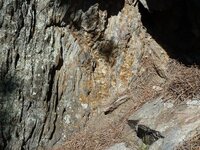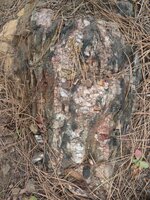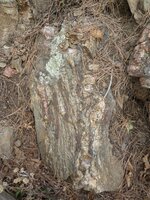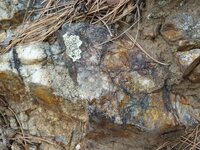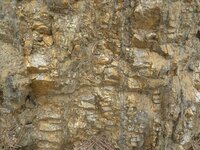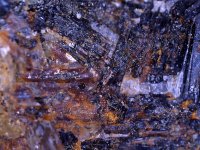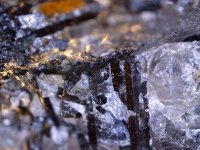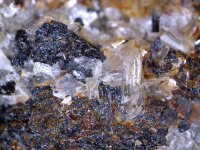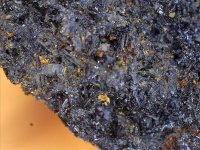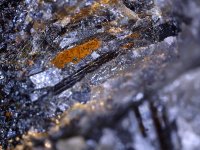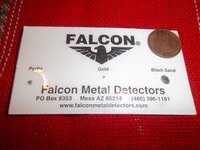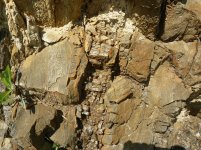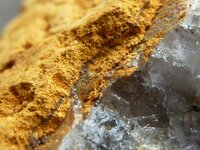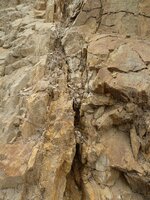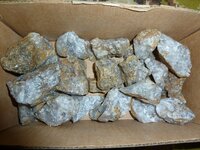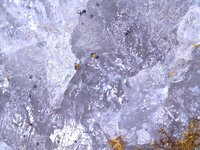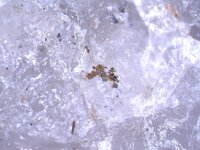I have a small parcel, 12 acres, with many varied outcrops. The geology is crazy. Many dikes and metavolcanics and quartz veins in a schist country rock. I've been sampling and have found some very small [hand lens] gold fragments. A half dozen assays have returned 3-5 grams per ton on surface grab samples. One assay showed 1/2 ounce per ton. I would dig for specimens if I knew where to look, but I have'nt a clue. Red quartz, grey quartz, yellow quartz. Ultramafic veins, felsic veins, Biotite walls or tourmaline walls, brecia, clay gouge diorite porphery veins. I don't know whether to dig or to just walk away. A mining venture is probably out of the question due to cost, regs, and size of deposit. I would be happy with some nice specimens if I could find some . Any ideas?
You are using an out of date browser. It may not display this or other websites correctly.
You should upgrade or use an alternative browser.
You should upgrade or use an alternative browser.
Some outcrops on the place.
- Thread starter 605dano
- Start date
dave wiseman
Hero Member
Keep sampling where your getting the gold and make sure to tag each sample so you know where it came from.If gold is present in a vein it may be just fine gold,species pockets or any combination of the above.Check your small gold with a loupe and see if it's rough and/or has minute quartz attached to it.This often a sign for species or pockets,but not always.Wherever your finding the yellow follow that up,down or in(following the lead).
Assembler
Silver Member
- May 10, 2017
- 3,103
- 1,184
- Detector(s) used
- Whites, Fisher, Garrett, and Falcon.
- Primary Interest:
- Prospecting
Both a gold type of metal detector and a falcon type of detector could help with finding 'Pockets of values'. Crushing and panning will help with the fine gold. Making a good log book on each sample area will help track down values,
Eu_citzen
Gold Member
- Sep 19, 2006
- 6,484
- 2,111
- Detector(s) used
- White's V3, Minelab Explorer II & XP Deus.
- Primary Interest:
- Prospecting
Agree with Dave. I'd also keep an eye out for vugs or other things indicating "cavities" in the quartz/host rock where crystals could potentially grow.
I'm curios about the tourmaline wall. Pics would be neat!
I'm curios about the tourmaline wall. Pics would be neat!
- Thread starter
- #5
EU here are some pics of the tourmaline wallrock on one of the veins. It's different than the tourmaline I find in pegmatite. Hydrothermal deposition I believe.
Attachments
bc5391
Hero Member
- Sep 23, 2016
- 533
- 764
- Detector(s) used
- Minelab ,XP
- Primary Interest:
- All Treasure Hunting
How big are the tourmaline crystals? larger ones are of value, the gem and mineral show is around the corner here in Tucson, other good sources are fleebay, gem and mineral forums.
RTR
Gold Member
- Nov 21, 2017
- 8,180
- 32,469
- Detector(s) used
-
Teknetics Liberator
Falcon MD-20
***********
Blue Bowl
Angus MacKirk sluice
Miller Table
- Primary Interest:
- All Treasure Hunting
Aufisher
Bronze Member
- May 12, 2013
- 1,948
- 4,830
- Detector(s) used
- Whites Goldmaster V/SAT. VibraProbe. Bazooka 48" Prospector Sluice. Shorts. Chickens + Goats + Goldhounds. 35' Chris Craft Caribbean motorsailer. FISH OIL + BURLAP
- Primary Interest:
- Prospecting
Nice looking rocks, thanks for sharing!
dave wiseman
Hero Member
.....But will it find a speck of gold that's two feet inside the vein in situ? No it won't and that's the reason you sample the veins properly.Any color found after samplinmg a quartz vein needs further sampling.Second that on the Falcon.It will find a speck of gold in solid rock (smaller than the sample showed View attachment 1520576 here).
Last edited:
- Thread starter
- #11
Thanks for all the replies. I went out and dug a little on a grey quartz vein a few days ago. The reason I keep going back to this vein is the quartz closely the ore from a nearby historical mine that had very rich ore, [ozs per ton]. I have yet to see visible to the eye gold there. It is very fractured in the vein, can dig out with screwdriver. It is close to a fault fissure feature and in a fine ground yellow clay. Biotite is the main accessory. Will try to crush and pan some soon. Took a couple pieces that were covered in limonite and soaked in hydrochloric acid. Didn't see any gold after. Am trying to concentrate on where I can see that fluids have penetrated. Hope springs eternal.
Attachments
RTR
Gold Member
- Nov 21, 2017
- 8,180
- 32,469
- Detector(s) used
-
Teknetics Liberator
Falcon MD-20
***********
Blue Bowl
Angus MacKirk sluice
Miller Table
- Primary Interest:
- All Treasure Hunting
I don't think I said IT will look thru "TWO feet of rock". However it did find this vein 1.75" inside this >.....But will it find a speck of gold that's two feet inside the vein in situ? No it won't and that's the reason you sample the veins properly.Any color found after samplinmg a quartz vein needs further sampling.
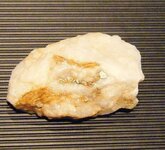
And it will find a 2/100s grain of gold , 1" thru rock.
Last edited:
dave wiseman
Hero Member
.........If that's the case ...Very impressive.I don't think I said IT will look thru "TWO feet of rock". However it did find this vein 1.75" inside this > View attachment 1521161
And it will find a 2/100s grain of gold , 1" thru rock.
Assembler
Silver Member
- May 10, 2017
- 3,103
- 1,184
- Detector(s) used
- Whites, Fisher, Garrett, and Falcon.
- Primary Interest:
- Prospecting
Yes the Falcon can have a range of about 1/2" - 3/4" for this one at times on larger values. Far deeper then one's eye's that is for sure. Thank you for the picture RTR  as this can show the range of the Falcon. The Falcon is really slow for anyone used to swinging a larger coil that is for sure.
as this can show the range of the Falcon. The Falcon is really slow for anyone used to swinging a larger coil that is for sure.
Assembler
Silver Member
- May 10, 2017
- 3,103
- 1,184
- Detector(s) used
- Whites, Fisher, Garrett, and Falcon.
- Primary Interest:
- Prospecting
Just a idea is with picture #2 try collecting the vein lines in the brown material next to the clear quartz and crush and pan that to see if there is any values. If you do find some values maybe try a Falcon detector out in the field to collect the better zone material for crushing and panning. The richer values may be in very dirty quartz and a Falcon detector or any gold type of detector could be of some use there as well. Think of the metal detector as a pinpointing tool to help find 'Sweet spots' to crush and pan as the real sample test and make a log book to help track down possible collector samples if that is what you are after. Keep us posted and thank you for the pictures 605danoThanks for all the replies. I went out and dug a little on a grey quartz vein a few days ago. The reason I keep going back to this vein is the quartz closely the ore from a nearby historical mine that had very rich ore, [ozs per ton]. I have yet to see visible to the eye gold there. It is very fractured in the vein, can dig out with screwdriver. It is close to a fault fissure feature and in a fine ground yellow clay. Biotite is the main accessory. Will try to crush and pan some soon. Took a couple pieces that were covered in limonite and soaked in hydrochloric acid. Didn't see any gold after. Am trying to concentrate on where I can see that fluids have penetrated. Hope springs eternal.
SaltwaterServr
Sr. Member
Thanks for all the replies. I went out and dug a little on a grey quartz vein a few days ago. The reason I keep going back to this vein is the quartz closely the ore from a nearby historical mine that had very rich ore, [ozs per ton]. I have yet to see visible to the eye gold there. It is very fractured in the vein, can dig out with screwdriver. It is close to a fault fissure feature and in a fine ground yellow clay. Biotite is the main accessory. Will try to crush and pan some soon. Took a couple pieces that were covered in limonite and soaked in hydrochloric acid. Didn't see any gold after. Am trying to concentrate on where I can see that fluids have penetrated. Hope springs eternal.
Hydrochloric acid?? You probably dissolved your fine gold. HCl used to be used quite a bit (relatively) to take gold into solution if amalgamation wouldn't work, and before cyanide came onto the scene.
Never rely on visual indications for gold in a rock. Send it for assay otherwise you will never know what you have. There isn't any other way to do it correctly.
dave wiseman
Hero Member
Hydrochloric (muriatic) acid alone won't put gold into solution..three parts hydrochloric and one part nitric will make royal water,also known as agua regia and put gold into solution.
SaltwaterServr
Sr. Member
Hydrochloric (muriatic) acid alone won't put gold into solution..three parts hydrochloric and one part nitric will make royal water,also known as agua regia and put gold into solution.
There are entire sections of The Chemistry of Gold Extraction by House and Marsden devoted to oxidation and leaching using chloride ions to form the Au(I) and Au(III) complexes without any nitric acid present. Add salt to HCl at pH of 2-3 and the leaching rate is faster than alkaline leaching through cyanide.
There is no need for Nitric acid or Aqua Regia to dissolve gold. Any Halide (including Chlorine) will suffice under the right conditions. There is however a blocking chemistry provided by the water and silica found in natural rock. You can dissolve your relatively refined gold (jewelry, placer nuggets) with chlorine or other halides but most gold ores are much more complex and contain things that block the reaction or cause the gold to precipitate back out of solution (iron is notable in that regard and is present in most in situ gold deposits).
Oxidation never takes place alone and is just part of the redox reaction. The introduction of other elements found in gold deposits almost assures that the application of a Hydrochloric acid will not have the intended effect. Best to leave the chemistry until you are mining and refining. Randomly applying acids to ore proves nothing about the quality of the ore. As stated here many times, before you can accurately determine the the composition of an ore you need to have a competent fire assay. Anything else is just an approximation of actual values at best.
The fire assay is the easy part. Understanding the nature of just what you are assaying is the highly skilled task that most fail at. Picking up obvious mineralized pieces of ore for fire assay is not a grab sample and in all cases the results are misleading. Better to stumble blindfolded over an ore pile and pick up pieces at random than to eyeball grab samples.
Heavy Pans
Oxidation never takes place alone and is just part of the redox reaction. The introduction of other elements found in gold deposits almost assures that the application of a Hydrochloric acid will not have the intended effect. Best to leave the chemistry until you are mining and refining. Randomly applying acids to ore proves nothing about the quality of the ore. As stated here many times, before you can accurately determine the the composition of an ore you need to have a competent fire assay. Anything else is just an approximation of actual values at best.
The fire assay is the easy part. Understanding the nature of just what you are assaying is the highly skilled task that most fail at. Picking up obvious mineralized pieces of ore for fire assay is not a grab sample and in all cases the results are misleading. Better to stumble blindfolded over an ore pile and pick up pieces at random than to eyeball grab samples.
Heavy Pans
gold tramp
Bronze Member
- Dec 30, 2012
- 1,379
- 2,879
- Primary Interest:
- Other
There is no need for Nitric acid or Aqua Regia to dissolve gold. Any Halide (including Chlorine) will suffice under the right conditions. There is however a blocking chemistry provided by the water and silica found in natural rock. You can dissolve your relatively refined gold (jewelry, placer nuggets) with chlorine or other halides but most gold ores are much more complex and contain things that block the reaction or cause the gold to precipitate back out of solution (iron is notable in that regard and is present in most in situ gold deposits).
Oxidation never takes place alone and is just part of the redox reaction. The introduction of other elements found in gold deposits almost assures that the application of a Hydrochloric acid will not have the intended effect. Best to leave the chemistry until you are mining and refining. Randomly applying acids to ore proves nothing about the quality of the ore. As stated here many times, before you can accurately determine the the composition of an ore you need to have a competent fire assay. Anything else is just an approximation of actual values at best.
The fire assay is the easy part. Understanding the nature of just what you are assaying is the highly skilled task that most fail at. Picking up obvious mineralized pieces of ore for fire assay is not a grab sample and in all cases the results are misleading. Better to stumble blindfolded over an ore pile and pick up pieces at random than to eyeball grab samples.
Heavy Pans
Have to just stick with my action mining leach manual its easier for me.
GT,,,
Last edited:
Top Member Reactions
-
 2283
2283 -
 1105
1105 -
 1029
1029 -
 909
909 -
 857
857 -
 764
764 -
 754
754 -
 735
735 -
 607
607 -
 505
505 -
 492
492 -
 478
478 -
 432
432 -
 420
420 -
 406
406 -
O
403
-
 401
401 -
 394
394 -
 378
378 -
 374
374
Users who are viewing this thread
Total: 2 (members: 0, guests: 2)


